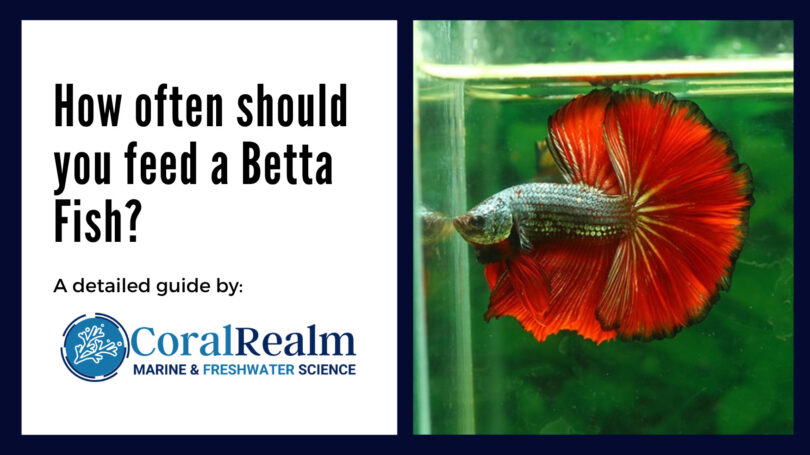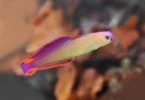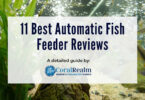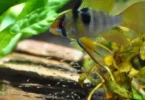Last Updated on February 13, 2023 by Jakob
The proper guidelines for feeding a Betta fish has always been a topic of contention. But by the end of this article you should know how often should you feed a Betta Fish. Feeding tropical fish is an essential part of maintenance of a fish tank, not least because it keeps your fish alive, but because overfeeding can result in a dirty tank, toxic waste and unprecedented algae growth. Betta fish are greedy little things and a common problem is assuming that because it’s eaten what you fed it, it must still be hungry.
In this guide, we’ll look at how often should you feed a betta fish and what varieties of food it can eat. Luckily, this fish is not a fussy eater, both from your perspective and the fish’s perspective too. We’ll have a closer look at what type of food the fish can eat, how often it can eat and how much it should be fed in one go.
Where feeding your fish becomes not so obvious is what you feed them, how much to feed them, the brand of food you feed them, and other questions like these.
Different fish have different preferences, different nutritional requirements, and different times of day they prefer being fed. Whilst we are going to be looking at the betta fish in this article, have a look here for a general guide on what to feed tropical fish.
Betta fish are omnivorous, which means that they eat both plant based and animal based foods. This gives you a greater range of foods which you can feed them.
IN THIS ARTICLE
How much should you feed a betta fish?
When you feed you betta you want to make sure that you do not overfeed or underfeed it. You want to ensure that your betta gets enough food but you don’t want it becoming overweight or having more left over food.
- In a community tank: The stomach of a betta fish is incredibly small. When you have a big tank full of fish, you typically follow the guidelines on the back of the packet, this says something like, feed what your fish can eat within 2 minutes. This rule can be followed when you keep betta fish with other species as there’s no way to limit what the betta eats. Feeding what can be eaten in 2 minutes should allow both the betta fish and other species to eat enough, without overfeeding. Have a look though, and if you betta fish is monopolizing the food and bullying other fish out of the way you can always try and move it with a net so your other fish can feed.
- If you keep the betta fish alone: As is what most people do, you should feed a betta fish what it can eat in 1 minute.
If you are feeding your betta with pelleted food, two to three pellets per feeding per fish will be plenty, and you won’t get a build up of wasted food.
The betta will keep eating as long as there is food. Remember, in the wild fish don’t have a steady and regular food source, and they’ll eat enough to survive. Fish aren’t smart enough to know they’re fed each day.
If you feed the fish brine shrimp or bloodworm, that’s about 3 individual pieces per betta.
If you give your betta too much food then it will begin to get overweight, and will feel the health impacts that come with that.
Feeding your betta fish too much will not only cause it to become unhealthy and overweight, it will also have knock-on effects for the water quality. You should feed your betta fish only what it needs. Excess food in the betta tank will cause the water quality to drop, and bettas like very high water quality. More waste food will mean more decomposing matter on the bottom of the tank, meaning more toxic ammonia and nitrite produced.
These released chemicals will pollute the water and can cause illness and disease in your betta. It can also cause the water to become dirty and murky. You will need to do more regular water changes as a result. If you feed betta fish too much you will need to be careful to remove all the excess waste from the bottom of the tank using an aquarium vacuum cleaner.
If you see your betta getting a bit of a belly, then it is a sign that you are feeding it too much. It’s a lot like a human really!
How often do you feed a betta fish?

A betta can be fed the required amount above once or twice per day.
Once in the morning and once in the evening, is the best way to ensure it doesn’t overeat. You do not need to feed them more often than this. Feeding them more often wouldn’t really give the fish any extra benefit, but instead would make the betta overweight as it tries to eat what you give it.
Feeding your betta fish too often will also just serve to introduce more waste into your aquarium. The food your betta doesn’t eat will decay and fester, causing the water to become dirty faster. This will mean you will need more frequent water changes and the contaminated water could cause sickness in your betta.
Feeding younger bettas is the same as adult bettas. Two times per day is the perfect amount.
Also skipping a feeding every now and again can actually benefit your betta fish. It can serve as a cleansing almost, enabling your betta to remove toxins and digest all the food in its stomach.
Skipping an evening meal, or even skipping a day can do your betta fish good in the long run. Just do not skip a day too often or you will starve your fish! Make sure to get straight back into the routine after the skipped meal though.

However, you are likely to receive conflicting advice, both from the back of the food container, and the person or place where you bought the fish food from. It is hard to find objectivity but you cannot go wrong with 3 pellets once of twice per day.
Some bettas are larger than others, so you can go for twice a day. For young and small bettas, do once per day. This is the only guideline as to the frequency of feeding.
In the wild, betta fish eat irregularly, so skipping a meal once in a while is no bad thing. Keep an eye on the fish to see how it handles the frequency of feeding. How often should you feed your betta fish depends on how bloated it becomes, how active or vibrant it looks and how much waste is in the tank.
We recommend that every so often the routine is changed for optimal health.
What can you feed a betta fish?
As we have already said, betta fish are omnivorous. In the wild they eat a mixture of insects, worms, and algae. So you should try and recreate this by feeding your betta a mixture of foods.
They do need a good supply of protein, so you can’t just feed them plant based food, they need the protein that comes in animal based food, or live foods will really whet their appetite!
Betta fish are not picky eaters. They eat almost all types of protein and in the wild they will hunt often, seeking out bloodworm, brine shrimp or small insects. Also known as Siamese Fighting fish, they have been known to kill and eat each other, especially in captivity. Obviously, the betta fish is a keen meat eater! Here’s our list of the top foods to feed your betta fish at home:
Betta Fish Pellets
These pellets are specifically designed and tailored to meet the dietary requirements of betta fish. This is usually the main food source that aquarists use for betta fish. As they are tailored for betta fish they hold a lot more nutritional value for bettas than flaked foods. You can buy betta pellets online by following the link or at your local pet store. Avoid using generic fish pellets if you can. Most pet stores will sell ‘betta specific’ foods, but I personally think it’s a profit making exercise, but I buy betta pellets none the less. I use TetraBetta PLUS Floating Mini Pellets.
Live betta food
Betta’s love live feed such as bloodworm, mosquito larva and daphnia and they are an important source of protein for betta fish. In their native habitat they would predate on similar insects, so providing them in the aquarium is important. You can get live foods at a pet store. They will be able to tell you how much to give your betta. Live food is the best option but it is also the most expensive. It is the most nutrient rich food and can even prolong the life of your fish.
Whilst buying live food from a pet store can be expensive if you do it often to feed your betta. However if you want a side project and also want your betta fish to be as healthy as it can be, and be fed live food as often as you should feed a betta, then you can raise your own.
Daphnia

Daphnia, or water flea, a common live betta food. Credit: NTNU (Flickr)
This isn’t as hard as it sounds. Raising your own betta live food is actually very easy. Daphnia are probably the easiest live food to raise so you can feed them often to your betta fish. Daphnia are extremely small planktonic crustaceans that live in freshwater lakes, ponds, and swamps.
They are also commonly called ‘water fleas’ due to their small size and jerky movements. All you need in order to raise daphnia is a bucket, tub, spare small aquarium or other appropriate container. Fill the tub up with treated water, you need to use a water conditioner on tap water, and leave it for a couple of days. Then put the daphnia eggs in. You can purchase daphnia eggs online or in a store. Simply wait 2 weeks ad the daphnia should be hatched and ready. They will eat the plankton and algae that grows in the tub. If you want them to breed do a 75% water change every couple of weeks.
Brine Shrimp

Brine shrimp, another common live betta food, often fed to betta fish as a more substantial meal. Credit: djpmapleferryman (Flickr)
Brine shrimp are a little trickier then daphnia to raise as live betta food, simply because they need saltwater and aeration. This doesn’t make it difficult though. It is advised to raise brine shrimp rather than daphnia, as a fully grown brine shrimp is a very substantial meal for a betta fish. Even at only a month old a brine shrimp is a significant bite.
All you need to raise them is a suitable container; any bucket or spare tank will do. To get the required salinity you should add 1.25 grams of good quality aquarium salt per 40ml of water. As for aeration, a simple air stone will do nicely. Leave the filled container for around 12 hours and then add the brine shrimp eggs. They should hatch within 18-36 hours. As said, after a month they will be a significant meal at a month old, and should be fully grown at around 6 weeks. Only one or two shrimp should be enough to feed a betta fish at mealtime.
Live betta food – caught from outside
I really love watching my fish eat the local mosquito larvae population, then there’s less to bite me! If you have a small net, simply go outside to a body of water that’s been sitting for a while, like a bucket, and you’ll find it full of mosquito larvae. It’s a great source of food for these small types of aquarium fish.
Frozen betta food
Frozen foods are essentially the same things as live foods, like bloodworms or brine shrimp, except they are frozen and not live. Having them frozen means they will keep longer and you will have a constant source of good quality protein for your betta in your freezer. Simply defrost them before you feed them to your fish. Whilst maybe not as good for your betta as the real live thing, frozen foods are a great source of proteins and are much easier to obtain! In comparison to live bloodworms, frozen blood worm is a lot less expensive.
We often feed our betta fish frozen and live bloodworm in combination. Remember, they only need to eat about 3 frozen bloodworms which is a tiny piece of the packet. About the same size as 3 pellets is a good rule to go by. This type of food is best for the fishes long term health, energy and vibrant color. It also helps prevent the fish from looking ill or depressed.
Freeze dried food
Another way of topping up your bettas protein intake, Omega One Freeze Dried Blood Worms can be bought online by following the link or from most pet stores. Freeze dried foods don’t need to be stored in the freezer, which is very useful as you can keep them with your other fish foods, and away from the nice food in the freezer you eat yourselves! This is extremely useful, as you
Fish flake food
Very cheap and easily available online or at your local pet store. Betta Flake Food are the most generic type of food you can buy. Fish flakes are the staple of most fish species, but bettas are a little picky, and have been known to turn their noses up at certain flaked foods. So always try a little first to make sure that they like it. And if you use flakes, your betta will need something else as well, like live foods, to keep them healthy.
Flakes are generally suited to all types of fish and not bettas. Only use for a short time and for convenience sake. Betta fish sometimes don’t eat flake food which is why most people use the betta pellets as a staple.
Here’s an overview list of what you can feed a Betta fish in less detail:
- Frozen or live bloodworms
- Live or Frozen daphnia
- Bloodworms in jelly (common way to package them)
- Glass worms
- Mosquito larve (frozen, store live or even better just fresh caught from outside)
- Brine Shrimp – can be frozen or alive
- White worms (live or frozen)
- Frozen small shrimp such as mysis shrimp
- Grindal and black worms are both potential substitutes for bloodworms, but can vary in price a lot depending on the provider. Can all be live or frozen, either are suitable.
- Flake food for bettas
- Betta specific pellets
- Time release formulas for trips away
What should you NOT feed a betta fish?

As mentioned previously, we try not to stick to using pellet feed as it’s not best for the health of the betta fish. We tend to only use them for convenience and for others who may come round to look after the fish.
Try to avoid flake food altogether if you can. It is poorly made, with cheap fillers that provide no nutrient, but fill up the fish and are hard to digest. These foods are very cheap to produce so the profit margins are extremely high and they are often pushed as premium betta feed on labels.
Flakes and pellets both absorb a lot of water because they are so dry, and can expand the betta’s tiny stomachs. Flake food does this a lot more so than pellets due to the dry cheap filler content, that is cardboard like in it’s texture.
Going away from home and feeding your Betta Fish
A lot of people panic if they’re going away from home and worry that their fish might starve to death. While this is true, for short weekends away your fish will absolutely be fine without food. This is especially true of your fish is in a planted tank with plenty of aquarium plants. A planted tank with natural organic matter will always provide a source of natural food.
If your fish isn’t in a planted tank, don’t worry, a betta fish can go up to 2 weeks without eating before it dies. We wouldn’t advise that you let it go that long though, but know that you can go away for a weekend and the fish will be fine.
If you plan to go away for longer than 4 days, we strongly advise that you get a time release betta food feeder. This automatic fish feeder will gradually release the amount of food required, it’s much healthier for the fish.
We also advise that you keep bettas in a planted tank, such as these amazing aquascaping examples, and not one of these.
You can improve the quality of your betta tank by including a moss ball. They provide extra filtration and a natural food source for the fish. You can find available online easily.
Summary & takeaway – How often to feed a betta fish?
The food and nutrition you give your betta plays a huge part in its health. You can give a betta fish a perfect aquarium with perfect water quality; but if you don’t feed it correctly then it will still be unhealthy.
How often should you feed a betta fish depends on the type of food you feed it. Betta fish pellets are designed and formulated with bettas in mind, though flaked foods are good and are also very cheap. Betta fish eat insects in their natural habitat, so you need to give them a good supply of live foods or freeze dried or frozen foods such as bloodworms.
Always keep in mind how much you should feed the fish and always buy good quality food. It’s easy to overfeed and easy to forget that the fish will keep eating whatever you give it, jeopardizing its health and muddying the aquarium.
- Feed the betta fish live food as much as possible.
- Fish the 3 pellet size amounts once or twice a day, use pellet size as a guide when not using betta pellets.
- It’s ok for the fish not to eat for a couple of days, but don’t make it a regular thing.
Depending on where you purchased your Betta fish, you’re going to get different advice. Some might sell pellet food and suggest that it’s given to them every other day, some might have a daily regime but with less. If you’re confused please leave a comment and we’ll get back to you.
– CoralRealm.com Team











